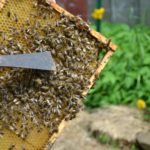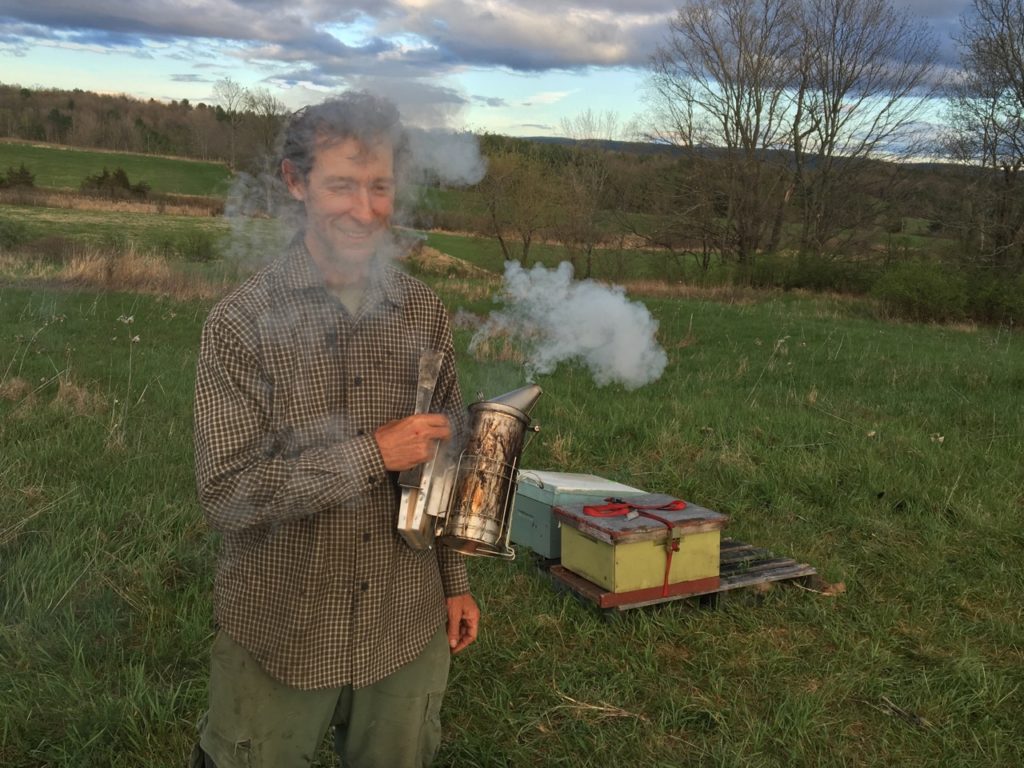Honey bees on the farm will pollinate our flowers. Todd began a relationship with honey bees over 50 years when he and his brother Tom, 9 years old, bought their first hive for their family farm. They were enchanted by how industrious the bees were, giving them honey, pollen, propolis and beeswax for candles and salve. Around 40% of what is eaten is pollinated by insects, this to a great degree by honey bees. Because there are so few nectar & pollen plants on Thornhill Farm, we are planting these plants for the bees. We know the soil is worn out on the farm because our honey bees make so little honey. This is why we have pigs. When the forest is cleared, we do not burn the wood that is left behind, but chip it and mix these wood chips with manure and fungus mycelium to make piles of compost to improve the soil. Last summer we grew peas and oats as a green manure crop, and the pea flowers gave voluminous amounts of nectar to the honey bees and pollinating insects.
Health & the Hive: A Beekeeper’s Journey
 A Jan Cannon Film that explores the importance of honeybees in our lives through the seasons of Honey Gardens Apiaries, Todd and the team. Topics addressed in the film include pollination, queen breeding, disease control, bee venom therapy, organic agriculture and honey-based plant medicine. 53 minute dvd. $10 + $4 (shipping).
A Jan Cannon Film that explores the importance of honeybees in our lives through the seasons of Honey Gardens Apiaries, Todd and the team. Topics addressed in the film include pollination, queen breeding, disease control, bee venom therapy, organic agriculture and honey-based plant medicine. 53 minute dvd. $10 + $4 (shipping).
to order, send a check to: 198 Taylor Road, Greensboro Bend, Vermont 05842
writings & images about the honey bees of Thornhill Farm
- Tim McFarline, McFarline Apiaries, Benson, Vermont June 3, 2016

Tim McFarline, McFarline Apiaries, Benson, Vermont. Tim raises queen bees organically from survivors and sells colonies of bees each Spring. We worked together for six years. May 2016.
Live from the Hive by Annie Watson – Winter 1997 to July 2015 archives
- Winter ArrivesBeehives near Kirstead Green, Norfolk, Great Britain. © Copyright Evelyn Simak and licensed for reuse under this Creative Commons License We’re heading to the bottom of the year now. In the last few months, the bees have worked hard to make enough honey to get through the winter and build up enough numbers to reproduce and ...
- Fruits of Their LaborsThe staghorn sumac (Rhus typhinia or Rhus hirta) flowers that the honeybees pollinated in June have developed into dark, velvety fruit clusters, or drupes. You can gather the drupes to make into a Vitamin C- and flavor-rich drink, or to dry and use next summer for your smoker fuel if you keep bees. Make sure ...
- The sweetness of fall and preparing for winterThe honey bees are going all out, searching the goldenrod plants for every last flower that offers another grain of pollen, another drop of nectar, carrying their precious loads of gold back to the hive. The honey they are making now will help them through the long winter. Purple asters are flowering, and these ...
- Let Your Broccoli Flower!It’s happened to us all: You go away for a few days, or it rains, or you get busy with other things and before you know it that head of broccoli in the garden is flowering. But wait – Did you know that broccoli and other members of its family are favorites of honeybees? Bees love ...
- Don’t Cut Your Burdock Down!The burdock is just starting to flower in Vermont. We think of burdock as a “pest plant” because the very tenacious “burrs” get caught in our clothes or our dog’s coat. But burdock flowers provide essential pollen and nectar for honeybees at this time of year, coming as they do when clover is on the wane and ...